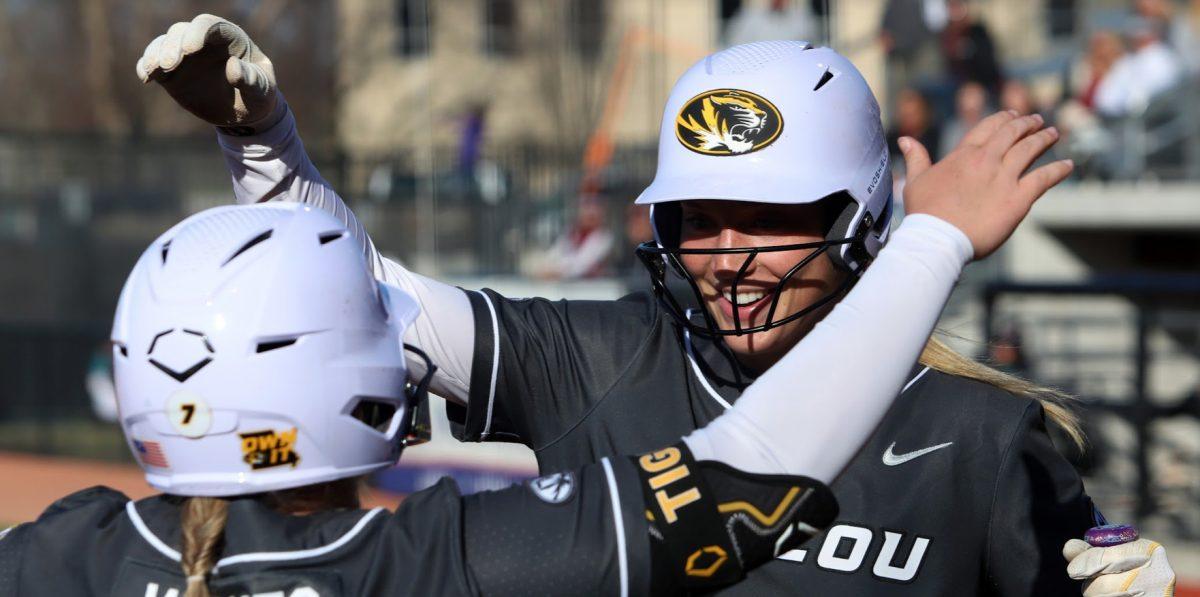
The date was March 6.
Missouri softball had just completed a four-game sweep in the Mizzou Tournament and capped a record-breaking weekend with the 12th no-hitter in program history. The sweep improved the Tigers to 16-4 and helped them retain a No. 8 ranking in the USA Softball Collegiate Top 25.
Then, everything changed.
Inclement weather forced Missouri’s next three-game series into a single-day double-header on March 13, and the Tigers lost both games to the visiting Tennessee Lady Vols. Missouri earned two victories against Illinois in a double-header on March 16 to bounce back, but the tides turned once again in the Mizzou Classic tournament.
Missouri dropped three of its four games in the tournament, including a 4-3 loss to a 6-16 Ball State team on March 20. Ole Miss swept the Tigers in their next series from March 25-27, dropping Missouri to 0-5 in Southeastern Conference play. With little trending in the right direction, the Tigers lost an 11-7 slugfest against border rival Kansas on March 30.
Missouri responded with a series sweep at home against South Carolina last weekend, bringing a sense of relief and optimism to the team. However, the Tigers remain in the bottom third of the SEC standings and have a tough conference schedule remaining.
Missouri’s record faltered from 16-4 to 22-13 in less than a month, and the Tigers plummeted in the rankings after holding a top-10 spot. A key reason behind this skid is Missouri’s offensive production, which has a couple glaring weaknesses that have changed its trajectory altogether.
Missouri’s inability to manufacture runs
It is no secret that Missouri relies heavily on hitting home runs to jumpstart its offense. However, when the Tigers struggle to send softballs over the wall, their offense goes stagnant.
Missouri ranks No. 6 in the SEC in home runs with 51, but remains in the bottom three of several key offensive categories: batting average (.290, No. 12), on-base percentage (.371, No. 13), runs scored (183, No. 12) and RBIs (166, No. 12). On top of struggling to reach base, the Tigers are No. 4 in the SEC in strikeouts with 182 and No. 10 in walks.
But what do these statistics mean?
These numbers show that Missouri has trouble getting on base, moving base runners into scoring position and driving them in. They suggest that the Tigers are efficient at hitting for power but inefficient in reaching base via other means. Essentially, the Tigers struggle to manufacture runs.
During its 6-9 stretch, Missouri played eight games against SEC opponents and scored only 25 runs in those contests. The Tigers hit eight home runs, which accounted for nine of their 25 total runs and managed a .224 batting average. When excluding home runs, Missouri only averaged two runs per game over those eight contests.
The Tigers’ offensive limitations impact their ability to provide run support for their pitchers as well, forcing them to have an over-reliance on the pitching rotation. With most teams in the SEC averaging over four runs per game, Missouri’s offense is asking a lot for its pitchers to hold opponents to a low run total.
With a lower batting average and on-base percentage, the Tigers also struggle to advance the base runners they put on, limiting their ability to piece together consistent offensive performances. Instead, Missouri relies on hard hits to pace its production and drive itself to victory.
There is a silver lining to this offensive output, however.
In Missouri’s victory over Kansas, the Tigers scored all seven runs without a single home run. Additionally, the series sweep over South Carolina featured two home runs, which only accounted for two of Missouri’s 13 total runs in the series.
Recent progress like this highlights a trend in the right direction for the Tigers and provides a recipe for creating a healthier balance between home runs and manufactured runs on the offensive side.
A lack of production in the bottom half of the batting order and bench
Missouri fans are used to hearing the names of fifth-year infielder Kimberly Wert, sophomore shortstop Jenna Laird and redshirt senior infielder Kendyll Bailey. However, they have not heard many names from those in the bottom half of the batting order or the bench lately.
The usual six players who rotate throughout the No. 1-6 spots in the Tigers’ batting order all hold batting averages around Missouri’s team average of .290: Laird (.348), Bailey (.343), Wert (.360), graduate outfielder Brooke Wilmes (.284), sophomore infielder Alex Honnold (.309) and freshman infielder Kara Daly (.281).
Senior first baseman Emma Raabe (.200) and graduate catcher Hatti Moore (.148), who usually bat in the No. 7 and No. 8 spots, hit well below the average. However, redshirt senior outfielder Casidy Chaumont leads the team with a .409 batting average and typically bats No. 9 in the lineup.
Five players have 13 or more at-bats off the bench, but none of them hit above .231 nor have an on-base percentage above .316. Without a true impact bat off the bench and limited production from the bottom half, Missouri is showing a heavy reliance on the top of its order to carry the offense.
Over the Tigers’ eight SEC games, only three players have hit above .250, and the bench unit as a whole is 2-22. Raabe, Moore and Chaumont have a combined average of .106 in these games, emphasizing the inconsistency coming from the bottom third of the batting order.
Establishing a stronger balance between the entire batting order and role players off the bench will give the Tigers an opportunity to enhance their offense at a time when it matters most. Missouri has 17 games remaining this season with 15 of them coming against fellow SEC programs, giving the Tigers a tough road ahead. However, if Missouri is able to flip the script on offense, then it will be in prime position to head to the postseason once again. Edited by Riley Gearhart | [email protected]